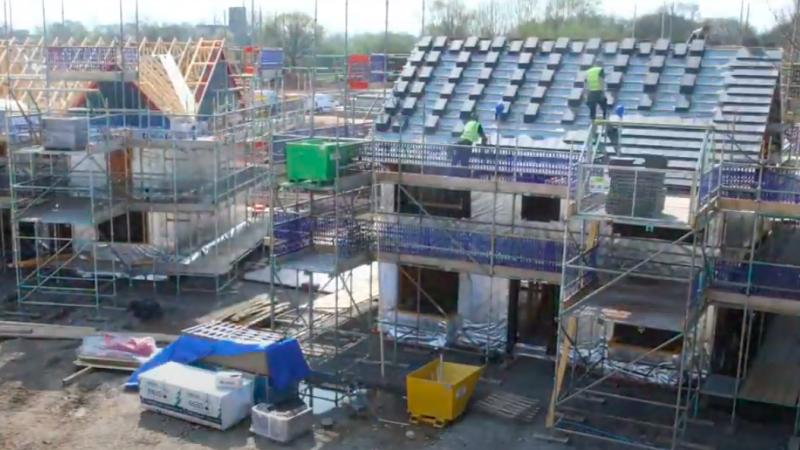High prices are a barrier to home ownership, but no party has explained how it is going to reduce them and what the consequences of that may be.

Prem Sikka is an Emeritus Professor of Accounting at the University of Essex and the University of Sheffield, a Labour member of the House of Lords, and Contributing Editor at Left Foot Forward.
UK politics is reduced to populist slogans, which deliver neither prosperity nor happiness to the people.
Remember the 2010 general election campaign, when Liberal Democrats promised to abolish university tuition fees. After the election, they formed a coalition government with the Conservatives and by the end of the year the fees tripled.
The 2019 Tory election manifesto promised not to increase income tax. But in March 2021 the government froze income tax thresholds and personal allowance for four years, effectively a tax increase on people securing a pay rise to combat inflation.
In 2020, to become leader of the Labour Party, Sir Keir Starmer gave ten pledges. These included public ownership of utilities and railways, and the abolition of university tuition fees. All have since been diluted or abandoned. Inevitably, people grow sceptical of party promises.
Leaving aside questions about wilful manipulation of public opinion, political parties rarely connect the dots to make deliverable promises. The issues can be illustrated by examining promises made to expand the supply of housing and encourage home ownership.
In 2003 70.9% of the households owned the homes they lived in. Since then there have been stamp duty holidays and shared home ownership schemes. After the 2007-08 financial crash, interest rates also plunged, but home ownership declined. In 2021, 62.5%, (15.5 million) of households owned the accommodation they live in.
Conservatives say they want to see higher home ownership. The Labour Party wants to increase home ownership to 70% of households and “re-establish the link between genuinely affordable housing and average earnings”. However, little is said about how that would be achieved.
Major reasons for the decline in home ownership are erosion of real wages, soaring property prices and lack of housing stock. At the end of 2022, the median annual salary of a full-time worker was around £33,000 though there are considerable regional, gender and ethnicity differences. The median UK house price at the end of 2022 was £281,272, nearly 8.5 times the median pay.
To purchase a house, buyers need to provide a deposit of 10%-20% of the price. Due to low wages, this is beyond the reach of many. According to the Resolution Foundation 1.3 million families had no savings prior to the pandemic – including one-in-twelve of the poorest tenth of households. Almost half of families had savings worth less than a month’s income. The lack of savings is a huge barrier to home ownership.
Most people can’t service a mortgage of 7-9 times their salary. Many will be repaying well into their retirement. One answer is to increase real pay of workers, or at least recover the lost ground. In 1976, workers’ share of gross domestic product (GDP) in the forms of wages and salaries was 65.1%. At that time, a mortgage of 3.5 times the average salary enabled many to buy their first home. By the end of 2022, workers’ share of GDP declined to around 50%. The average real wage is lower than in 2007. However, no party has outlined policies for increasing workers’ share of GDP.
Workers’ share of GDP can’t be increased without reducing capital’s share of GDP. Yet no party has put forward any policies to do that.
High prices are a barrier to home ownership, but no party has explained how it is going to reduce them and what the consequences of that may be.
One approach is to lower the prices by increasing the supply by enacting barriers to second home ownership e.g. by bans, or levying higher stamp duty and taxes. But parties are not keen to upset landlords, corporate and foreign owners.
Another approach is to build more houses. The UK has a backlog of 4.3 million homes. At the current rate of 300,000 new homes a year it would take nearly half a century to fill the gap. By building 442,000 homes a year the backlog can be cleared in 25 years. Past attempts to build new homes, especially for first-time buyers, have had little success.
In 2015, the Conservative government promised to build 200,000 starter homes by 2020. By 2019, not even one new starter home was built. Builders looking to maximise profits have little interest in building low cost houses. Party policies offer no analysis or solutions.
There are supply chain constraints. Does the UK have sufficient number of carpenters, electricians, construction workers and construction materials? The UK is a major importer of bricks and domestic brick production has halved since 2008. Around 20% to 25% of the materials, by value, used in UK construction industry are imported. Political parties rattle-off slogans, but none explains how they will alleviate supply chain constraints.
A rapid increase in supply can reduce the price of houses, leaving millions with negative equity. No analysis of the consequences is offered by any party.
Any party interested in increasing housing supply and home ownership has to move beyond slogans and increase real wages, reduce return on capital, build more houses, tackle profiteering, social inequities and alleviate supply chain constraints. Due to poor policies and lack of details, housing crisis is likely to continue.
Left Foot Forward doesn't have the backing of big business or billionaires. We rely on the kind and generous support of ordinary people like you.
You can support hard-hitting journalism that holds the right to account, provides a forum for debate among progressives, and covers the stories the rest of the media ignore. Donate today.



